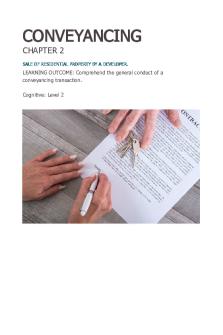Lecture 2 - ULAW LG2 notes PDF

| Title | Lecture 2 - ULAW LG2 notes |
|---|---|
| Course | Land Law |
| Institution | University of Law |
| Pages | 18 |
| File Size | 372.3 KB |
| File Type | |
| Total Views | 131 |
Summary
ULAW LG2 notes...
Description
Lecture 2
Third party rights over land and enforceability in unregistered land Introduction to third party rights Th way in which an owner is able to create for the benefit of another person, rights over his land that fall short of an ownership of an estate, but they’re still very valuable to that person, so the rights acquired by a non-owner. o Generally referred to as third party rights or INCUMBERANCES – as they incumber or they burden the lad in question Third party rights is a right that someone has over a property belonging to someone else. - These rights are important to the owner of that right because they’ll have an impact on how they use their own land -
For example it may be easier for them to access their land or ensure that they’re able to get a supply of water or electricity to their property
The most important third party rights 1. Covenants 2. Easements 3. Mortgages Often (but not exclusively) created on a sale of part. these rights are often, but not exclusively created when there is a sale of a part of a property their owner has a larger parcel of land and they sell a part of it and keep a part of it. - The seller might grant rights over the land he’s retaining for the benefit of the buyer or the seller might retain rights over the land he’s selling for his won benefit. - If these rights are enforceable and protected, they then become third party rights in respect of the land over which they’re enforceable that could involve new third party rights that have been created over both parts of the land
What issues arise on a sale of part? Activity 1: 5 Hawthorns Estate Watch the video clip and identify the issues that arise on a sale of a house on a housing estate.
-
-
How ben is going to access number 5 when he moves in – he will have to perhaps use the estate road – the estate road will belong to that builder = he’s going to need access to his house over the land What about the guests and workmen working on the other houses – can they use the estate road as well
-
-
-
How will Ben use his house? He will be wanting to receive utilities, service media through pipes and cables and clearly they run through his neighbour’s properties, so will he be able to use those pipes and cables that run through next door and beyond? Will any of bens neighbours want to use his property in that was aswell – perhaps there needs to be reciprocal rights form some of them On a housing estate there are boundaries for each plot, perhaps there’ll be issues with who the boundary walls or the fence belong to. Will they belong to ben and he’ll have to repair them and maintain them, or perhaps they’ll belong to his neighbours. Who will under obligation to maintain those walls or fences and should there be an obligation to keep them there and in a particular style. What about the way in which Ben wants to use that property. Do you think he should be able to use it for any purpose he wants or should he be restricted to using it perhaps as a dwelling. Perhaps that needs to be reciprocated on the other houses of that estate. So if his neighbours decide to use their properties for other things, let’s say commercial property purposes will Ben be able to stop them?
-
= lots of issues which relate to how Ben can use his land and how his neighbours can use their land. To avoid disputes going forward these issues will be dealt with the creation of third party rights and obligations .
What is a covenant? Relating to the scenario above: If the builder wants to ensure that the estate remains one that’s attractive to buyers then they’ll want to make sure that Ben doesn’t carry out noisy or offensive activities on the
property, and they may even want to ensure that he keeps the front garden tidy, something like that. They will also want to ensure that the owners of each house know which boundary is their responsibility and to keep fences up and in good order along their boundaries for privacy, so there’ll be an obligation not to remove them. issues like this might be dealt with by imposing covenants a)
Covenants are promises made by land owners to each other, which are usually contained in a deed. these promises will be written into the deed which transfers the land from the builders to them.
b)
Enforceable between the covenantor and the covenantee. Covenantor = made the promise, has the burden of complying with that promise Covenantee = the ones who are benefiting from the covenant.
c) -
Some covenants are enforceable between successors in title to the original parties. Some of the covenants can be passed to new owners.
d) Positive and restrictive covenants. Positive covenants = require the covenantor to take action to comply with that covenant. eg: Ben has to maintain a fence. To comply with that covenant he’s going to have to spend some money and time on maintaining the fence, perhaps replacing panels if they break ect. Restrictive covenants = prevent the landowner from doing something with his land. eg Ben might have to covenant to use the property only for residential purposes and only for one family. He can’t use it for business purposes or any other purposes, and he can’t use it for a dwelling for more than one family. So he’s restricted in what he can do with his land.
A covenant not to let a fence fall into disrepair kind of looks at first glance to be a restrict covenant because of the use of the word “not”. But when you think about what Ben will have to do to comply with that covenant it becomes clear that it’s actually a positive covenant. Ben is going to have to spend money and do work to comply with it. Likewise, if there was a covenant not to make any amendments or any alterations to that property without getting the builders consent that could appear to be a positive obligation to ask for consent when he wants to do any work, but what it’s really doing is restricting Ben’s right to make alterations to his property. So when you’re trying to decide whether you’ve got a positive or a restrictive covenant you have to think about the effect of the covenant rather than the words used to draft it.
Activity 2: What is a Covenant? Ben is purchasing No 5 The Hawthorn Estates There are a number of covenants in the deed by which the land is transferred to Ben. Decide whether the following statements are true or false. 1. -
True it is making him do something. 2.
-
The builder of The Hawthorns Smithsons has promised not to allow businesses to be run on the estate. This is a restrictive covenant. True or False?
True, they will have to ensure that this restrictive covenant is binding on all the other buyers of the estate, because that’s a separate process, but its definitely restrictive in nature
4. -
In regards to this covenant, Tim is the covenantee. True or False?
False, he’s a covenantor, he’s the promisor, not the person benefiting from it, so he’s not the covenantee.
3. -
Ben has promised to keep the exterior of No.5 The Hawthorns neat and tidy at all times. This is a positive covenant. True or False?
With regard to the covenant given by the builder Ben is, the covenantee. True or False?
True, he is going to be the beneficiary, the promise, the peron that been promised that everyone will be prevented from running businesses, so he’s benefitting from tht promise made by the builders. He’s the covenantee.
What is an easement? a) A right enjoyed by an owner of land over land of another e.g. a right of way, right to drainage, right of light. - Most easements are positive rights to do something, such as use a driveway. - Other easements = rights of way over private roads and footpaths. The right to park a car perhaps in the communal car park in a housing development or apartment block. The right to use the stairways or the lifts in a block of flats ect. - Easements can also be negative in nature = rare. they’re giving the owner of the easement the right to restrict his neighbour’s use of his land. eg: if your neighbour’s greenhouse has an easement to receive which actually flows over your property then that’s going to prevent you from building on your land in a way which would block your neighbour’s right to light only a few negative easements are recognised by the court b) An easement forms part of the land.
-
Land includes both corporeal and incorporeal hereditaments An easement is an example of an incorporeal hereditament you can’t see it, you can’t touch it, but once its created an easement is part of the land and so it passes with that land when it’s sold
-
c) An easement is usually created in a deed. They may arise in more informal circumstances Expressed easements between parties should be created in a deed.
Distinguishing a covenant from an easement Both covenants and easements can come into existence at any time by agreement between neighbouring owners of land. Both can come into existence in similar circumstances and together, theyre often confused
Activity 3: Distinguishing a Covenant from an Easement Identify whether the right that has been created in the following situations is a covenant or an easement. 1.
A, by deed, grants his neighbour, B, the right to use the path that runs across the rear of A’s garden as a short-cut from B’s house to the local shops. Is this a covenant or an easement? - Easement – it’s a right enjoyed by B over A’s land
2.
In a deed, B agrees to pay A half the cost of maintaining the path which he is using as a short-cut. Is this a covenant or an easement? - Covenant – it’s a promise made by B in a deed
3.
In a deed, C promises his neighbour, D, that C will not build any structure on his land. Is this a covenant or an easement? - Covenant – it’s a promise that C is making to D in a deed. It happens to be restrictive promise, restrictive covenant and he’s making it in a deed.
4.
By deed, E grants his neighbour, F, a right to use cables, pipes and drains, which run through E’s property, for the supply of services to F’s land. Is this a covenant or an easement? - Easement – it’s a right enjoyed by F over E’s property. He woudn’t ordinarily have it, but he’s been granted that right by E over E’s land.
Contracts to buy and sell land – the effect of exchanging contracts (Estate Contracts)
-
-
-
a)
Parties are contractually bound to complete the performance of that contract.
b)
Seller retains legal title and the right to physical possession of that property.
c)
Buyer has an estate contract capable of specific performance.
If they refuse to transfer the property on the agreed date for completion, the buyer can go to the court and demand that the contract is properly performed. If all goes well and it does in the vast majority of cases, the parties will complete that transaction on the day that’s agreed in the contract. Most conveyancing of houses, of land, there will be a relatively short period of time between the exchange and contracts and completion, the day of the actual transfer of the legal title of the interest. There are other types of agreement which can exist for much longer periods of time. eg: if a landowner, like a local authority, thinks it might want to sell some of its land at some point in the future then they might enter another form of estate contract with a developer and give them an option to purchase that land. It could be a right of first refusal when they decide to eventually sell that land. d) Option to purchase another type of estate contract. Called an option. An option to purchase, and those kinds of options can be really valuable to both developers and owners of land There is some certainty, there’s some exchange of contractual promises. It doesn’t necessarily mean it’s going to happen or it’s going to happen immediately or very soon.
e) Buyer can protect the contract by registration. These estate contracts is a potential buyer can protect their right to buy that land by registration. it is either on the land registry, if you are dealing with registered land, or in the unregistered land system. - If it’s properly protected, then the current owner of the land should be prevented from selling the land to anyone except the party who has he benefit of that option to purchase or that contract for the sale and purchase of the land. - So a contract for the sale of land, including an option to buy the land, are more types of these third party rights or incumbrances over land. -
What is a mortgage? mortgage = narrow legal meaning, used by the public in a more general sense to describe what’s going on when a homeowner secures a loan by a bank or building society that allows them to purchase a house. a) Security for a loan. To secure the loan, the lender will ask you to enter into a mortgage and if they don’t pay the money back the lender can have quite strong rights to sell the house to recover what is owed. - The majority of people today when they are buying a property will do so with the help of this kind of loan from a bank or a building society or an independent finance house. - Because of the size of the loan it’s going to be normal for that lender to ask for some security over the assets, over that house to ensure that the loan is going to be repaid in the event that perhaps the buyer, who’s the borrower, gets into trouble and defaults on those payments. - The security over the house or the asset of the property = a mortgage -
b)
A charge by way of legal mortgage (created by deed) is the only method available for registered land.
Interests under a trust o Have their roots, in the old feudal system introduced by William the conqueror – 1066 – when he took over the running of our land. o A trust allows a legal title in the land and the equitable title in the same land to be split so that one person can be in control of the land and look after it for the benefit of the other. = legal and equitable ownership split o Where there’s a trust in place there’s a legal estate which is being held effectively by two owners. It’s a split. o The legal owners are called trustees – they own the legal estate, o Equitable owners are called beneficiaries - owns the equitable interest, the lagal estate that’s holding the equitable interest for the beneficiaries. Some trusts are created expressly by the way of a trust or deed or in the document in which the partied purchase the land. - Sometimes they arise through the operation of law – a trust is created impliedly - It doesn’t matter how they arise, when the property is held by a person or more than one person on trust for another, then you have a trustee and a beneficiary. - That is a default position. - To the outside world = the legal owner, the trustee of the trust, is the owner and they will be entitled to deal with that property as if they were the absolute owner with nobody else involved.
-
Equity steps in – it won’t ignore the interests of the beneficiaries, and equity will protect those interests against new buyers or new lenders of that land. = it will protect beneficial interests, the equitable interests, against successors in title.
So when purchasing land or granting a mortgage on it, it’s essential that the purchaser, so the buyer, or the bank or building society, the lender, the mortgagee, is able to discover whether that property is subject to a trust of land, and if it is then they must take steps to be able to take that land from the owner, the trustee, free of those beneficial interests. -
In other words, they need to be able to make sure they can sell the land without having to be bound by those equitable interests under the trust.
Statutory right of occupation for spouse/civil partner of legal owner In the 1960’s – the govt at the time recognised there’s a problem for spouses, predominantly wives whose husbands owned the homes that they both lived in, an the husband owned that house in his sole name. - But then, if the marriage broke down, then they were in danger of being thrown out that home or displaced by the husband selling that property Govt passed Matrimonial Homes Act 1967 o Provided that a spouse would have right of occupation whilst the marriage is going to be in existence o Until and unless the marriage ends by divorce or death of the legal owner, usually the husband at the time. Protection is now embodied in: a) Conditions in s30 Family Law Act 1996. – creates a statutory right of occupation for a spouse and now a civil partner. s30(7) = does not apply to a dwelling house which has at no time been and was at no time intended to be a matrimonial home in the marriage. o the home is or has been or was intended to be the matrimonial home. If the property isn’t one of those then it won’t apply
s30(8) = these home rights continue so long as the marriage or the civil partnership subsists o in other words, the other parties must be legally married, not divorced and one of the parties (the owner) hasn’t died.
s30(2) = calls these rights home rights. o Good thing because it should remind you that it’s generally to do with the right to occupy a home and no other type of property. o They also encompass both married people but also now people in a civil partnership.
b) Not a proprietary right. It is a statutory right and not a proprietary right
It is not granting the spouse any ownership rights in the property itself, it’s just protecting them from eviction until such time as the issue of the ownership of the property will be resolved, and that’s usually divorce proceedings. It’s a right that has come about by statute. It is not something that has been created by law and it is specifically as a result of this family law act.
c)
Can only be enforced against a buyer if registered.
Third party rights and interests in land: legal, equitable or statutory? Before the 1925 act, conveyancing was generally a nightmare because of so many estates and interests in the land that existed, that had evolved through lots of common law, case law ect and through the Court of Chancery at the time, and there were loads that could be legal and equitable, and there were loads that could be legal and equitable, and there were loads of different rules of creation of these rights and these estates and so on. - So it was decided to classify the estates and the interests into those that could be legal and those that could only be equitable. Much easier system under Law of Property Act 1925 There are only 5 interests that are capable of being legal interests and those are listed in : a) Legal - s1(2) Law of Property Act 1925. o The only interests or charges in or over land which are capable of subsisting or being conveyed or created at law are an easement… or a charge b y way of legal mortgage. o The only interests capable or being created by law, that means they’re only ones being created as legal interests. o An easement includes a right or a privilege I or over land for an interest equivalent to an estate in fee simple absolute in possession or a term of years abslute b)
Equitable - s1(3) Law of Property Act 1925.
- All trust interests are equitable. o An estate contract is an equitable interests, a covenant over land is an equitable interest. o Any interest of a beneficiary under a trust is an equitable interest. o They can only ever be equitable.
c) Rights capable of being legal which take effect in equity o Another situation in which an interest might also be classed as an equitable one, that is where even if it appears i...
Similar Free PDFs

Lecture 2 - ULAW LG2 notes
- 18 Pages

Questions lg2
- 1 Pages

Lecture notes, lecture 2
- 3 Pages

2 - Lecture notes 2
- 5 Pages

Lecture notes, lecture Chapter 2
- 11 Pages
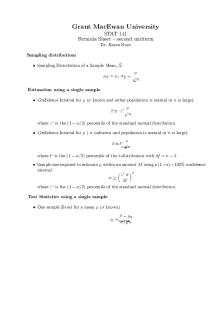
Lecture notes, lecture formula 2
- 1 Pages

2 Biodiversity - Lecture notes 2
- 33 Pages

Chapter 2 - Lecture notes 2
- 30 Pages
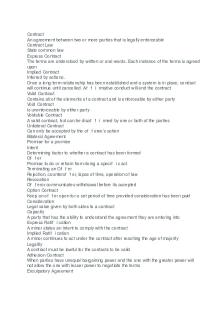
Blaw 2 - Lecture notes 2
- 4 Pages

Chapter 2 - Lecture notes 2
- 4 Pages
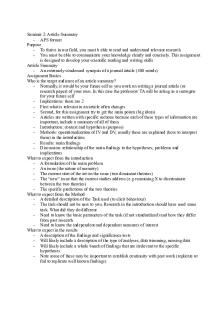
Seminar 2 - Lecture notes 2
- 2 Pages
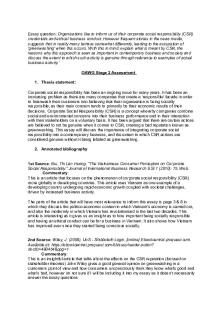
Stage 2 - Lecture notes 2
- 3 Pages
Popular Institutions
- Tinajero National High School - Annex
- Politeknik Caltex Riau
- Yokohama City University
- SGT University
- University of Al-Qadisiyah
- Divine Word College of Vigan
- Techniek College Rotterdam
- Universidade de Santiago
- Universiti Teknologi MARA Cawangan Johor Kampus Pasir Gudang
- Poltekkes Kemenkes Yogyakarta
- Baguio City National High School
- Colegio san marcos
- preparatoria uno
- Centro de Bachillerato Tecnológico Industrial y de Servicios No. 107
- Dalian Maritime University
- Quang Trung Secondary School
- Colegio Tecnológico en Informática
- Corporación Regional de Educación Superior
- Grupo CEDVA
- Dar Al Uloom University
- Centro de Estudios Preuniversitarios de la Universidad Nacional de Ingeniería
- 上智大学
- Aakash International School, Nuna Majara
- San Felipe Neri Catholic School
- Kang Chiao International School - New Taipei City
- Misamis Occidental National High School
- Institución Educativa Escuela Normal Juan Ladrilleros
- Kolehiyo ng Pantukan
- Batanes State College
- Instituto Continental
- Sekolah Menengah Kejuruan Kesehatan Kaltara (Tarakan)
- Colegio de La Inmaculada Concepcion - Cebu


